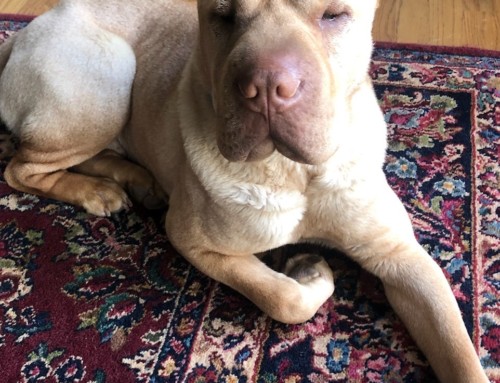My beloved Pembroke Welsh Corgi, named Kitty (yes, a dog named Kitty!), joined my family when she was a year and a half old. About six months later, she had her first seizure. By the time we got her to the vet, she had had several more seizures and her body temperature was so high that she had to be covered in ice packs & hydrated via IV fluids. She survived, but we walked away with a diagnosis of “idiopathic epilepsy”. She began taking Phenobarbital, a powerful drug that is also used in prison executions. I was told that once she started taking it, she could never stop. The Phenobarbital masked the seizures for a while, but eventually they came back. Our vet at the time remarked that the journey with an epileptic pet is hard and expensive, and “offered” euthanasia as an alternative. I declined, and decided to continue down the standard pharmaceutical treatment route. Over the course of the next two years, Potassium Bromide and Gabapentin (generic Neurontin) were added to Kitty’s regimen, all eventually landing at the maximum doses that her little body can handle. With each added medication, each increased dosage, the seizures stopped for a while, but were never truly “cured.” Along with this very serious issue came a relatively minor, yet very uncomfortable, problem – a total regression in potty training. While the medications controlled the seizures with a marginal level of efficacy, my active, fun-loving Corgi seemed to be slipping away – constantly drugged and lethargic with intermittent bouts of clustered seizure activity.
Flash forward to early 2016, Kitty was on the maximum doses of three powerful medications, but still experiencing grand mal seizures several times per month… with a new problem cropping up – focal seizures affecting her head and front legs several times per day. Our previous veterinarian was at a loss – we had nowhere left to go in terms of increased medication. For the second time, euthanasia was suggested. This time, I took some time to think about it. It was clear that Kitty’s quality of life was already low, with almost no chance of improving. She was ashamed of the messes she made in the house; knowing better, but not being able to control herself. After a seizure, her big brown eyes told me, “I’m just so tired.” I gave long, hard, painful thought to the idea of letting Kitty go, so that she didn’t have to suffer anymore. I hoped that there would be someone, somewhere, who could help Kitty, and resolved to try something “outside of the box” before making any life-altering decisions. Knowing that the only alternative was something I could barely stomach, I set out to do some research on alternative therapies for idiopathic canine epilepsy.
I have almost no experience with alternative treatment of any kind. I am a natural skeptic of anything that isn’t considered “main stream,” but I promised myself going into this that I would power through the skepticism. Through a fortuitous Google search, I found Dr. Moorehead and MainStreet Veterinarians, and learned of Nutrition Response Testing (NRT). I decided to give it a shot, and scheduled our first appointment at the beginning of March 2016. After the first visit, we left with Kitty’s first program of all-natural remedies aimed at treating the imbalances & weaknesses in her body, not just masking the symptoms (seizures) with dangerous pharmaceuticals. The change was almost instantaneous – within two days, the focal seizures had stopped – and so did Kitty’s using the bathroom in the house. As Dr. Moorehead told me to expect, there have been several “layers” to the diagnosis and treatment of underlying health issues, and there have been what seemed like setbacks – but, all temporary, and all quickly addressed by Dr. Moorehead. In essence, just the body’s way of saying “Alright, that’s fixed… time to focus on something else now.” As of this writing, at the end of June 2016, Kitty has been totally seizure-free for one month. One WHOLE month! Something I never thought we would see. In addition, she has gone back to using the doggy door to go outside to relieve herself. Her energy level is great; she runs, jumps and smiles again. The active, fun-loving pet that I believed to be lost forever… is back, better than ever, happy & healthy & always in the mood for a quick run around the yard and some quality time with her dad.
Skeptical as I may have once been, NRT has proven itself to work. On top of an effective therapy, I can’t say enough about the professionalism and dedication shown by Dr. Moorehead and his staff. He always takes the time to explain what he’s doing – what’s being tested, why, what it means, and what to expect moving forward. The clinic staff – the admin team, vet techs, and everyone in between – are always a pleasure to work with. They remember both me & Kitty by name, every time. You can tell that they are genuinely concerned for the animals in their care. They operate efficiently and on schedule, a quality that is so important with a hectic schedule such as my own. The costs associated with this treatment are reasonable, and the results are obvious & abundant.
I could never thank Dr. Moorehead and his staff enough for the love & care they have shown Kitty, which has greatly improved her quality of life – and by extension, my own. Looking back, it’s hard to think that I came so close to having to make a painful decision about Kitty’s future. My one and only regret is that I didn’t find Dr. Moorehead sooner. If your pet is healthy, he will help to keep them that way. If your pet is not healthy, he will work to solve the problem, not just mask the symptoms. Either way, Dr. Moorehead & his staff help to keep their patients happy, healthy, and a part of their loving families for as long as possible. I would urge anyone and everyone to make Dr. Moorehead the primary care provider for the pets you so deeply love.




